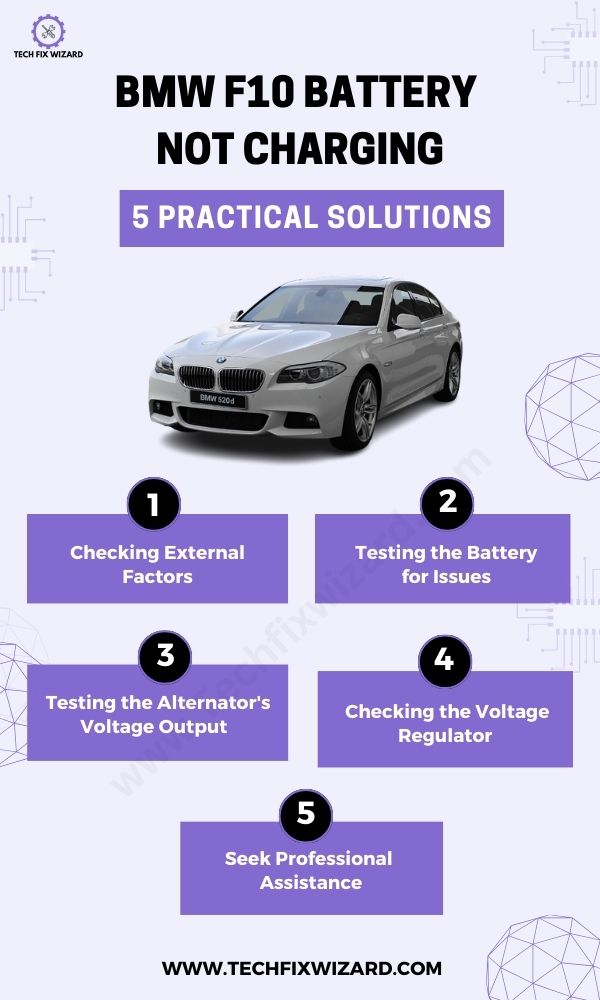The BMW F10 is a popular luxury sedan known for its sophisticated design, powerful performance, and advanced features.
However, like any vehicle, it may encounter occasional technical issues that require attention.
One common problem reported by BMW F10 owners is a battery that fails to charge properly. If you’re one of the such owners then worry not we’re here to help you!
In this article, we will discuss potential solutions to troubleshoot the BMW f10 battery not charging.
Contents
- 1 Troubleshooting BMW F10 Battery Not Charging – 5-Step Solution
- 2 1. Checking External Factors
- 3 2. Testing the Battery for Issues
- 4 3. Testing the Alternator’s Voltage Output
- 5 4. Checking the Voltage Regulator
- 6 5. Seek Professional Assistance
- 7 Preventive Maintenance Tips for BMW F10 Owners
- 8 FAQs
- 9 Why is my BMW F10 battery not charging?
- 10 How can I check if the alternator is causing the battery not to charge?
- 11 What should I do if my BMW F10 battery is not holding a charge?
- 12 Can a faulty battery sensor cause the battery not to charge?
- 13 What are some signs of a bad alternator in a BMW F10?
- 14 Why is my BMW F10 battery draining quickly?
- 15 How can I diagnose a parasitic draw on my BMW F10?
- 16 What should I do if I suspect a parasitic draw on my BMW F10?
- 17 Can extreme temperatures affect battery charging in a BMW F10?
- 18 How often should I replace the battery in my BMW F10?
- 19 Can a software update fix battery charging issues on a BMW F10?
- 20 What should I do if none of the troubleshooting steps resolve my BMW F10 battery charging issue?
- 21 Official References & Resources
Troubleshooting BMW F10 Battery Not Charging – 5-Step Solution
Following are the solutions that will guide you through the process of identifying and resolving the charging issue, ensuring that your BMW F10’s battery functions optimally.

Also Read: Bmw F20 Battery Not Charging – 8 Solutions To Try
1. Checking External Factors
Before delving deeper into the troubleshooting process, it is crucial to examine external factors that could be contributing to the BMW F10 battery not charging issue.
This step involves a thorough inspection of components such as the belt, pulley, wiring, and battery connections. Once you have evaluated and addressed these external factors, you can proceed confidently to the subsequent steps of troubleshooting.
1. Inspect the Belt and Pulley for Wear or Damage:
- Open the hood of the BMW F10 and locate the engine compartment.
- Visually inspect the belt that drives the alternator for wear, cracks, or fraying.
- Check the tension of the belt by pressing on it with your finger, ensuring it has a slight give.
- Examine the pulley connected to the alternator, ensuring it spins freely without obstructions.
- Consider replacing the belt or pulley if significant damage or wear is detected.
2. Checking All Wires and Connections:
- Turn off the engine and disconnect the negative terminal of the battery using a wrench.
- Examine the wiring connections between the battery and the alternator. Ensure they are tight and secure.
- Check for any loose or damaged wires in the charging system. Repair or replace them if necessary.
- Reconnect the negative terminal of the battery and ensure it is tightly secured.
3. Verifying the Condition of the Battery Terminals and Cables:
- Inspect the battery terminals for corrosion, rust, or damage. Clean them if necessary.
- Check the battery cables for fraying, cracks, or loose connections. Tighten or replace as needed.
- Ensure the battery is securely mounted in its tray and there are no loose connections.
- Consider replacing the battery if it is old or showing signs of deterioration to ensure proper charging.
2. Testing the Battery for Issues
After inspecting the external components, it is important to test their performance to troubleshoot the issue of the BMW F10 battery not charging.
The testing process begins with evaluating the battery and then proceeds to test the alternator and voltage regulator. This systematic approach allows for a comprehensive diagnosis of the problem
Here are three common tests you can conduct to test the performance of your battery:
| Test | Procedure | Result |
|---|---|---|
| 1. Voltage Test | Use a voltmeter to check the voltage of the battery while the engine is off and then while it is running.
The readings should be around 12.6V and 14V respectively. |
Low voltage readings indicate that the battery may not be holding a charge properly or that there could be an issue with the alternator. |
| 2. Load Test | Connect a load tester to your battery and measure its ability to hold a charge under heavy loads. | If the reading shows less than 9.6V, then it means that the battery is weak and needs replacement. |
| 3. Conductance Test | This test uses specialized equipment that measures how well electricity flows through your battery. | A low score on this test indicates that there are issues with your battery’s internal components. |
By conducting these tests, you can pinpoint any issues affecting your BMW F10’s charging system. If all three tests show signs of problems, then it’s likely time for you to replace your car’s battery.
Replacing the Battery in a BMW F10:
After conducting the necessary testing, if you determine that your BMW F10 requires a battery replacement, you can follow the steps below:
- Turn off the engine and engage the parking brake.
- Remove the trunk floor cover to access the battery compartment.
- Refer to the vehicle’s manual or online resources to locate the battery.
- Disconnect the negative terminal (-) using a wrench or socket.
- Disconnect the positive terminal (+) using a wrench or socket.
- Remove any retaining brackets or straps securing the battery.
- Lift the old battery out of the compartment, being careful not to tip or spill.
- Position the new battery in the compartment and secure it with brackets or straps.
- Connect the positive terminal (+) and tighten the terminal nut securely.
- Connect the negative terminal (-) and tighten the terminal nut securely.
- Test the new battery by starting the engine and checking for any issues.
3. Testing the Alternator’s Voltage Output
It’s time to put the alternator to the test and see if it’s producing enough voltage to keep your car running smoothly.
| Step | Description |
|---|---|
| 1 | Ensure the car is turned off and remove any jewelry or loose clothing that could get caught in the engine. |
| 2 | Locate the alternator under the hood. |
| 3 | Find the positive and negative terminals on the alternator. |
| 4 | Connect the red lead of the voltmeter to the positive terminal of the alternator. |
| 5 | Connect the black lead of the voltmeter to a ground point on your car, such as an unpainted bolt or metal surface. |
| 6 | Start your car and check the voltage output on the voltmeter. |
| 7 | A healthy alternator should produce between 13.5-14.5 volts while running. |
| 8 | If the alternator is not producing enough voltage, there may be an issue with its wiring or components. Consider replacing your alternator or consult a professional mechanic. |
Replacing the Alternator of the BMW F10:
Follow the steps below to replace the alternator to resolve the charging issue:
- Ensure the engine is off and engage the parking brake.
- Open the hood and locate the alternator at the front of the engine.
- Disconnect the negative battery cable using a wrench or socket.
- Disconnect the wiring harness from the alternator.
- Loosen the bolts or adjust the bracket securing the alternator.
- Remove the old alternator from its mounting position.
- Position the new alternator in the mounting location.
- Secure the new alternator with bolts or adjusting brackets.
- Reconnect the wiring harness and electrical connectors.
- Reconnect the negative battery cable and tighten the terminal nut.
- Close the hood and start the engine to test the new alternator.
Also Read: Bmw F20 Battery Not Charging – 8 Solutions To Try
4. Checking the Voltage Regulator
Now look at the voltage regulator and see if it could be causing any problems with your car’s charging system. The voltage regulator is responsible for controlling the amount of voltage that goes into your car’s battery.
If the voltage regulator is faulty, then it may not be sending enough power to charge the battery properly. To check the voltage regulator, a multimeter is required.
| Step | Description |
|---|---|
| 1. | Disconnect the negative terminal on your battery |
| 2. | Locate the voltage regulator, which should be near or attached to the alternator |
| 3. | Connect your multimeter to both terminals of the voltage regulator |
| 4. | Start your car |
| 5. | Check the multimeter readings while the car is running |
| 6. | The multimeter should read between 13-14 volts, indicating that your alternator and voltage regulator are working correctly |
| 7. | If the multimeter readings are outside of this range, it suggests a faulty voltage regulator that needs to be replaced |
A bad voltage regulator can cause various issues such as overcharging or undercharging of batteries leading to premature failure of batteries or other electrical components in your vehicle.
Replacing the Voltage Regulator:
- Turn off the engine and engage the parking brake.
- Turn off the engine and engage the parking brake.
- Open the hood and locate the alternator at the front of the engine.
- Disconnect the negative battery cable using a wrench or socket.
- Identify the voltage regulator located within or on the alternator housing.
- Disconnect the electrical connectors or wiring harnesses from the voltage regulator.
- Remove the screws or bolts securing the voltage regulator to the alternator housing using an appropriate tool.
- Gently separate the voltage regulator from the alternator housing, taking care not to damage surrounding components or wiring.
- Position the new voltage regulator in place, aligning it with the mounting points on the alternator housing.
- Insert and tighten the screws or bolts to secure the new voltage regulator to the alternator housing.
- Reconnect the electrical connectors or wiring harnesses to the new voltage regulator, ensuring a secure connection.
- Reconnect the negative battery cable and tighten the terminal nut securely.
5. Seek Professional Assistance
Seeking professional assistance is recommended if the troubleshooting steps have not resolved the BMW F10 battery not charging issue.
A qualified mechanic or automotive technician will have the expertise and specialized equipment to diagnose and address complex electrical problems.
Remember, seeking professional assistance not only helps resolve the immediate battery not charging issue but also ensures the longevity and reliability of your BMW F10’s electrical system.
It is important to consult an experienced professional to accurately diagnose and address any complex electrical problems to avoid further damage or complications.
Also Read: BMW F30 Battery Not Charging – 7 Solutions To Try
Preventive Maintenance Tips for BMW F10 Owners
Now that you’ve learned about replacing the battery or alternator to fix your BMW F10’s battery not charging issue, let’s discuss preventive maintenance tips.
These tips can help you avoid costly repairs and ensure your car runs smoothly.
| No. | Maintenance Tips |
|---|---|
| 1. | Regularly check and clean battery terminals |
| 2. | Ensure the battery is securely fastened in place |
| 3. | Monitor voltage levels and recharge as needed |
| 4. | Consider using a trickle charger when not in use |
| 5. | Pay attention to warning signs and address them |
| 6. | Follow the manufacturer’s recommended maintenance schedule |
FAQs
Why is my BMW F10 battery not charging?
The battery may not be charging due to a faulty alternator, loose or corroded battery connections, or a defective battery itself.
How can I check if the alternator is causing the battery not to charge?
To check the alternator, start the car and measure the voltage across the battery terminals. If the voltage is below 13.8 volts while the engine is running, it could indicate a problem with the alternator.
What should I do if my BMW F10 battery is not holding a charge?
If the battery is not holding a charge, it may need to be replaced. Before replacing it, make sure to check the alternator and battery connections for any issues.
Can a faulty battery sensor cause the battery not to charge?
Yes, a faulty battery sensor can prevent the battery from charging properly. The sensor may need to be replaced or recalibrated.
What are some signs of a bad alternator in a BMW F10?
Some signs of a bad alternator include dimming headlights, a battery warning light on the dashboard, electrical issues, and a dead battery.
Why is my BMW F10 battery draining quickly?
A rapid battery drain can be caused by issues such as a parasitic draw, malfunctioning electrical components, or leaving lights or accessories on when the engine is off.
How can I diagnose a parasitic draw on my BMW F10?
To diagnose a parasitic draw, you can use a multimeter to measure the current flow from the battery. If there is a significant current draw when the car is off, it may indicate a parasitic draw issue.
What should I do if I suspect a parasitic draw on my BMW F10?
If you suspect a parasitic draw, you can try disconnecting fuses one by one to identify the circuit causing the draw. Once identified, further troubleshooting can be done to pinpoint the exact cause.
Can extreme temperatures affect battery charging in a BMW F10?
Extreme temperatures, both hot and cold, can affect battery performance and charging. It is important to keep the battery and charging system in optimal condition.
How often should I replace the battery in my BMW F10?
The lifespan of a battery can vary depending on usage and conditions. On average, a car battery may last between 3 to 5 years.
Regular maintenance and monitoring can help determine when a replacement is needed.
Can a software update fix battery charging issues on a BMW F10?
In some cases, a software update from the manufacturer can address certain battery charging issues. It is recommended to consult with a BMW dealership or authorized service center for assistance.
What should I do if none of the troubleshooting steps resolve my BMW F10 battery charging issue?
If the issue persists despite troubleshooting, it is advisable to consult with a professional BMW mechanic or contact BMW customer support for further assistance.
Our Popular Posts:
- BMW Wireless Not Charging – 9 Causes And Easy Fixes
- BMW Wallbox Not Charging – 6 Effective Solutions To Try
- BMW Not Charging iPhone – 7 Quick & Easy Solutions
Official References & Resources
Our research for providing accurate information about BMW involved a thorough analysis of official resources, including the official BMW website owner’s manuals, technical specifications, and relevant support forums.
Our research and data gathering involved thorough analysis of the official websites, including:

John Paul is a tech enthusiast dedicated to troubleshooting. He is passionate about fixing glitches, simplifying complexities, and empowering others in the digital realm.

